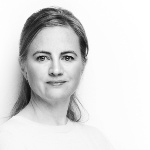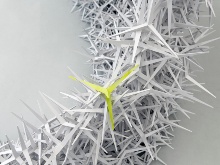Granular Architectures
Granular materials as "designer matter" in architecture
The thesis investigates designed granular materials in architecture. Granular materials are defined as high numbers of particles larger than a micrometre, between which mainly short-range repulsive contact forces are acting. In a designed granular material the geometry and material of the individual particle are determined by a designer. Consequently, the overall granular material can have characteristics which are novel in comparison to non-designed granular materials. In architecture, designed granular materials are understood to have new characteristics which fulfil specific architectural performance criteria.
The relevance of designed granular materials in architecture is threefold. All granular materials are both fully recyclable and reconfigurable due to the fact that the individual particles are in no way bound to each other. These first two aspects alone make any granular material, whether it is designed or not, a highly pertinent strand of architectural design research. However, designed granular materials, in addition to being recyclable and reconfigurable, bear the potential for the development of entirely novel material behaviours.
In the context of architecture, designed granular materials can be considered as a form of "material systems", and more specifically as a sub-group of "aggregate systems". In the wider transdisciplinary context, designed granular materials for architecture can be considered a form of "designer matter (DM)". "Designer matter (DM)" is understood as matter which is designed in its structural characteristics at its mesoscale rather than its macro- or its microscale.
The current state of research into designed granular materials is presented for both architecture and granular physics, on a conceptual as well as on a project-based level. In this context the thesis aims to establish and validate a first version of a comprehensive design system for exploring designed granular materials in architecture and for interfacing with granular physics.
The research development of this thesis is presented and evaluated with respect to the practical, methodological and conceptual foundations which have been laid during this phase.
The methods are introduced in terms of methodological frameworks, tools and techniques and the applied research methodology.
The core part of the thesis comprises a design system with a related design system catalogue as well as two case studies.
The design system is established for particle systems and for related construction systems. It formulates the basic system categories and corresponding parameters. The design system catalogue is presented in the appendix and summarizes tests which investigate individual aspects of the overall design system for particle and construction systems.
Each of the two case studies explores the integration of a different set of design system categories. They were conducted both through full-scale prototypes and a related set of tests with statistical repetition. Case study 1 investigates vertical structures made from a designed granular material consisting of highly non-convex particles. Case study 2 combines two designed granular materials, one consisting of convex particles and the other of highly non-convex particles, in order to form spatial enclosures. The case studies are evaluated with respect to their practical, methodological and conceptual contributions to architectural design research.
The thesis is summarized and its contributions are assessed in conclusion both with respect to the field of architecture and for the field of granular physics.
Further research in the field of designed granular materials in architecture can be conducted on the practical, methodological and conceptual levels of design. On the practical level, in the area of particle systems the investigation of graded granular materials, of different mechanical properties of the particles' material or of designed granular materials consisting of particles with variable geometry is highly promising. In the area of construction systems, the development of behavioural models of robotic construction is very relevant. Another key direction is for the construction systems to become increasingly simple, while the particles are progressively designed to perform parts of the construction process by themselves. On the methodological level, the integration of "inverse" design methods is the logical next step. This can be done on the basis of the proposed design system. On the conceptual level, the framework of "designer matter (DM)" needs to be further established both as a transdisciplinary model and within the field of architecture. Only then can designed granular materials be fully discussed as one form of "designer matter (DM)" in architecture.
Key to any further development of the overall research field is the integration of the two fields of architecture and granular physics.
ICD Institute for Computational Design and Construction - Prof. Achim Menges
Scientific Development
Karola Dierichs
Research Assistants
Christian Arias, Miguel Aflalo, Martin Alvarez, Bahar al Bahar, Elaine Bonavia, Giulio Brugnaro, Federico Forestiero, Pedro Giachini, Matthias Helmreich, Shir Katz, Ondrej Kyjanek, Martin Loucka, Alexandre Mballa-Ekobena, Christine Rosemann, Jasmin Sadegh, Emily Scoones, Alexander Wolkow, Leyla Yunis, Jacob Zindroski
Funding
GettyLab
Holcim Awards for Sustainable Construction
ITASCA Consulting Group, Inc.
Research Buildings / Prototypes
Informed Matter - Aggregate Structure 2013
Educational Projects
Aggregate Architectures ITECH Master Thesis 2nd Year - Project 1
Aggregate Architectures ITECH Master Thesis 2nd Year - Project 2
Aggregate Architectures ITECH Master Thesis 2nd Year - Project 3
Aggregate Architectures ITECH Master Thesis 2nd Year - Project 4
Aggregate Architectures ITECH Master Thesis 2nd Year - Project 5
Aggregate Architectures ITECH Master Thesis 2nd Year - Project 6
Publications
Dissertation
Dierichs, K.: 2020, Granular Architectures: Granular Materials as „Designer Matter“ in Architecture. Research Reports Institute for Computational Design and Construction, 2. Universität Stuttgart. DOI: 10.18419/opus-10765.
Peer-reviewed papers
Dierichs, K., Wood, D., Correa, D., Menges, A.: 2017, Smart Granular Materials: Prototypes for Hygroscopically Actuated Shape-Changing Particles, in ACADIA – Disciplines & Disruption [Proceedings of the ACADIA Conference 2017], Cambridge, MA, pp. 222-231.
Barés, J., Zhao, Y., Renouf, M., Dierichs, K., Behringer, R.: 2017, Structure of Hexapod 3D Packings: Understanding the Global Stability from the Local Organization, in EPJ Web Conf 140, S. 06021. DOI: 10.1051/epjconf/201714006021.
Zhao, Y., Ding, J., Barés, J., Zheng, H., Dierichs, K., Menges, A., Behringer, R.: 2017, Vibrational Collapse of Hexapod Packings, in EPJ Web Conf 140, S. 06011. DOI: 10.1051/epjconf/201714006011.
Rusenova, G., Dierichs, K., Baharlou E., Menges, A.: 2016, Feedback- and Data-driven Design for Aggregate Architectures: Analyses of Data Collections for Physical and Numerical Prototypes of Designed Granular Materials, in Posthuman Frontiers: Data, Designers, and Cognitive Machines, Proceedings of the 36th Conference of the Association for Computer Aided Design in Architecture (ACADIA), Ann Arbor, pp.62-72.
Dierichs, K., Angelova, D., Menges, A.: 2015, Modelling Aggregate Behaviour, in Ramsgaard Thomsen, M., Tamke, M., Gengnagel, C., Faircloth, B., Scheurer, F. (eds.): Modelling Behaviour – Proceedings of the Design Modelling Symposium Copenhagen 2015, Copenhagen/Denmark, Springer, Cham Heidelberg New York Dordrecht London, pp. 5-15.
Dierichs, K., Menges, A.: 2015, Non-convex Designed Aggregates as Architectural Material Systems, in Proceedings of the Particle Simulations Conference 2015, Erlangen/Germany, pp. 96-97 [Poster].
Topic, N., Pöschel, T., Dierichs, K., Menges, A.: 2015, Packings of Complex Shaped Particles in Cylinders, in Proceedings of the Particle Simulations Conference 2015, Erlangen/Germany, pp. 53-54.
Angelova, D., Dierichs, K., Menges, A.: 2015, Graded Light in Aggregate Structures – Modelling the Daylight in Designed Granular Systems Using Online Controlled Robotic Processes, in Martens, B., Wurzer, G., Grasl, T. Lorenz, W., Schaffranek, R. (eds.), Real Time – Proceedings of the 33rd eCAADe Conference – Volume 2, Vienna University of Technology, Vienna/Austria, 16-18 September 2015, pp. 399-406.
Dierichs, K., Menges, A.: 2015, Simulation of Aggregate Structures in Architecture: Distinct-Element Modeling of Synthetic Non-Convex Granulates, in Block, P., Knippers, J., Mitra, N., Wang, W. (eds.): Advances in Architectural Geometry 2014, Springer, Cham Heidelberg New York Dordrecht London, pp. 1-13. (ISBN: 978-3-319-11417-0 (Print) 978-3-319-11418-7)
Dierichs, K., Menges, A.: 2013, Aggregate Architecture: Simulation Models for Synthetic Non-convex Granulates, in Adaptive Architecture, Proceedings of the 33rd Annual Conference of the Association for Computer Aided Design in Architecture (ACADIA) Waterloo/Buffalo/Nottingham, pp. 301-310.
Dierichs, K., Schwinn, T., Menges, A.: 2013, Robotic Pouring of Aggregate Structures – Responsive Motion Planning Strategies for Online Robot Control of Granular Pouring Processes with Synthetic Macro-Scale Particles, in Brell Cokcan, S., Braumann, J. (eds.), Proceedings of the Robots in Architecture Conference 2012, TU Vienna, Springer, Vienna, pp. 196-205. (ISBN 978-3709114643)
Dierichs, K., Menges, A.: 2012, Functionally Graded Aggregate Structures: Digital Additive Manufacturing with Designed Granulates, in Synthetic Digital Ecologies, Proceedings of the 32nd Annual Conference of the Association for Computer Aided Design in Architecture (ACADIA), San Francisco, pp. 295-304.
Dierichs, K., Menges, A.: 2012, Material and Machine Computation of Designed Granular Matter: Rigid-Body Dynamics Simulations as a Design Tool for Robotically-Poured Aggregate Structures Consisting of Polygonal Concave Particles, in Achten, H., Pavlicek, J., Hulin, J., Matejdan, D. (eds.), Digital Physicality – Proceedings of the 30th eCAADe Conference, Czech Technical University in Prague, Faculty of Architecture (Czech Republic) 12-14 September 2012, pp. 711-719. (ISBN 978-9-4912070-3-7)
Dierichs, K., Menges, A.: 2012, Aggregate Architectures, Observing and Designing with Changeable Material Systems in Architecture, in Costa, X., Thorne, M. (eds), Change, Architecture, Education, Practices – Proceedings of the International ACSA Conference, Barcelona, Spain, 20-22 June 2012, pp. 463-468. (ISBN 978-0-935502-83-1)
Dierichs, K., Menges, A.: 2012, Material und Machine Computation als Grundlage Experimenteller Ästhetik in der Aggregat Architektur, in Kongress-Akten des VIII. Kongress der Deutschen Gesellschaft für Ästhetik 2011, www.dgae.de/kongress-akten.html.
Dierichs, K., Fleissner, F., Menges, A.: 2011, Interrelation of experiment and simulation in the development of Aggregate Architectures, in Digital Proceedings of the International Symposion on Algorithmic Design for Architecture and Urban Design (ALGODE) in Tokyo (Japan), 14-16 March 2011.
Dierichs, K., Menges, A.: 2010, Material Computation in Architectural Aggregate Systems, in Life In:Formation: On Responsive Information and Variations in Architecture, Proceedings of the 30th Conference of the Association For Computer Aided Design In Architecture (ACADIA), New York City, pp. 372-78.
Dierichs, K., Menges, A.: 2010, Natural Aggregation Processes as Models for Architectural Material Systems, in Proceedings of the Design and Nature Conference 2010, Pisa, Italy, Southampton, WIT, pp. 17-27. (ISBN: 978-1845644543)
Articles
Dierichs, K., Kyjánek, O., Loucka, M., Menges, A.: 2019, Construction robotics for designed granular materials: in situ construction with designed granular materials at full architectural scale using a cable-driven parallel robot, in Construction Robotics, Springer. doi: 10.1007/s41693-019-00024-6.
Dierichs, K., Menges, A: 2017, Granular Construction: Designed Particles for Macro-Scale Architectural Structures. Archit. Design, 87, pp. 88–93. doi:10.1002/ad.2200.
Dierichs, K., Menges, A.: 2016, Towards an Aggregate Architecture: Designed Granular Systems as Programmable Matter in Architecture, Granular Matter, 18 (25), DOI: 10.1007/s10035-016-0631-3.
Zhao, Y., Liu, K., Zheng, M., Bares, J., Dierichs, K., Menges, A., Behringer, R.P.: 2016, Packings of 3D Stars: Stability and Structure, Granular Matter, 18 (24), DOI: 10.1007/s10035-016-0606-4.
Dierichs, K., Menges, A.: 2015, Granular Morphologies – Programming Material Behaviour with Designed Aggregates, Architectural Design, Vol. 85 No. 5, Wiley, London, pp. 86-91. (ISBN 978-11118878378)
Dierichs, K., Menges, A.: 2012, Aggregate Structures: Material and Machine Computation of Designed Granular Substances, Architectural Design, Vol. 82 No. 2, Wiley Academy, London. pp. 74-81. (ISBN: 978 0470973301)
Patents
Dierichs, K., Menges, A., Schwinn, T.: 2013, Herstellung architektonischer Strukturen aus Aggregaten konkaver Gebilde, German Patent No. 10 2012 100 334.3, Filed 16.01.2012.
Contact Information

Karola Dierichs
Dr.-Ing.Doctoral Candidate and Tutor


